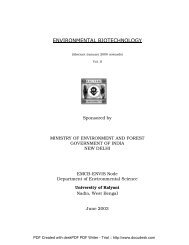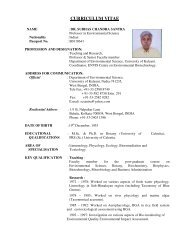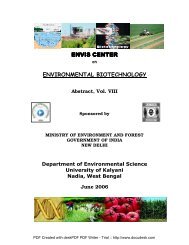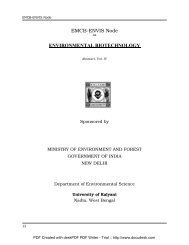EMCB-ENVIS Node ENVIRONMENTAL BIOTECHNOLOGY
EMCB-ENVIS Node ENVIRONMENTAL BIOTECHNOLOGY
EMCB-ENVIS Node ENVIRONMENTAL BIOTECHNOLOGY
You also want an ePaper? Increase the reach of your titles
YUMPU automatically turns print PDFs into web optimized ePapers that Google loves.
<strong>EMCB</strong>-<strong>ENVIS</strong> Centre<br />
About 0.7 g cell dry weight were formed from 1 g hydrocarbon. The experiments demonstrate<br />
the feasibility and efficiency of extreme thermophilic PAH and alkane biodegradation.<br />
Helia Radianingtyas, Phillip C. Wright. (Biochemical Engineering and Environmental<br />
Technologies Group, Department of Chemical and Process Engineering, Heriot-Watt<br />
University, Riccarton, Edinburgh EH14 4AS, UK. Biological and Environmental Systems<br />
Group, Department of Chemical and Process Engineering, University of Sheffield, Mappin<br />
Street, Sheffield S1 3JD, UK). 2-Propanol degradation by Sulfolobus solfataricus.<br />
Biotechnology Letters, 25(7) (2003), 579-583.<br />
Sulfolobus solfataricus used 2-propanol and 2-propanone (acetone) when grown in static cultures<br />
at 78 °C with or without glucose at 10 g l-1. The presence of 3.92 g 2-propanol l-1 in both cases<br />
inhibited growth. However, acetone accumulation following 2-propanol depletion suggested that<br />
2-propanol was co-metabolized via the acetone metabolic pathway. Glucose at 10 g l-1 increased<br />
2-propanol and acetone utilization from 0.93 g l-1 to 1.77 g l-1 and from 0.11 g l-1 to 1.62 g l-1,<br />
respectively. Without glucose, immobilized S. solfataricus cells increased the 2-propanol<br />
removal rate to 0.035 g l-1 h-1, compared to 0.0012 g l-1 h-1 by its suspended counterpart. The<br />
results suggest the establishment of an immobilized reactor configuration is preferential for the<br />
treatment of high temperature solvent waste streams by this acidothermophilic Crenarchaeon.<br />
Hojae Shima, EungBai Shina, Shang-Tian Yangb. (Department of Civil and Environmental<br />
Engineering, Hanyang University, 1271 Sa-1-Dong, Ansan, Kyungkido 425-791, South<br />
Korea. Department of Chemical Engineering, The Ohio State University, 140 West 19th<br />
Avenue, Columbus, OH 43210, USA). A continuous fibrous-bed bioreactor for BTEX<br />
biodegradation by a co-culture of Pseudomonas putida and Pseudomonas<br />
fluorescens. Advances in Environmental Research,7(4)(2003),889-900.<br />
A co-culture of Pseudomonas putida and P. fluorescens immobilized in a fibrous-bed bioreactor<br />
was used to degrade benzene, toluene, ethylbenzene and xylenes (collectively known as BTEX),<br />
present as sole carbon sources in contaminated water. The kinetics of BTEX biodegradation in<br />
the fibrous-bed bioreactor operated under the liquid-continuous condition was studied.<br />
Biodegradation rates of BTEX increased with increasing BTEX concentration and reactor<br />
loading rate. For benzene, the maximum biodegradation rate was 38 mg/l/h at a loading rate of<br />
265 mg/l/h. For toluene, the rate was 45 mg/l/h at a 100 mg/l/h loading rate. Aeration was not<br />
used in the process and the addition of hydrogen peroxide (H2O2) as an additional oxygen<br />
source improved benzene and toluene biodegradation for the high strength synthetic wastewater<br />
feeds. When benzene, toluene, ethylbenzene and para-xylene were present as a mixture in the<br />
feed, they were concurrently and completely biodegraded under hypoxic conditions (no addition<br />
of air or H2O2). The total BTEX biodegradation rate was as high as 600 mg/l/h at the highest<br />
BTEX loading rate, 1000 mg/l/h, studied. Individual BTEX compounds were efficiently and<br />
concurrently degraded at a retention time of less than 15 h. Immobilized cells adapted in the<br />
bioreactor showed no preferential degradation of BTEX present as mixtures. The bioreactor also<br />
had a stable long-term performance, maintaining its ability for efficient BTEX degradation<br />
without requiring additional nutrients (e.g. glucose) for more than 1 year. The good performance<br />
of the fibrous-bed bioreactor was attributed to the high cell density and unique cell<br />
immobilization process provided by the fibrous matrix, which allowed use of the reactor for<br />
continued regeneration, adaptation and selection of efficient BTEX degraders in the bioreactor<br />
environment.<br />
Hong-Gyu Song. (Division of Biological Sciences, Kangwon National University Hyoja-dong<br />
192-1, Chuncheon 200-701, South Korea). Degradation of humus-bound metabolites<br />
generated from toluene and o-xylene in soil. International Biodeterioration &<br />
Biodegradation, 51(2) (2003), 129-132.<br />
58<br />
PDF Created with deskPDF PDF Writer - Trial :: http://www.docudesk.com







